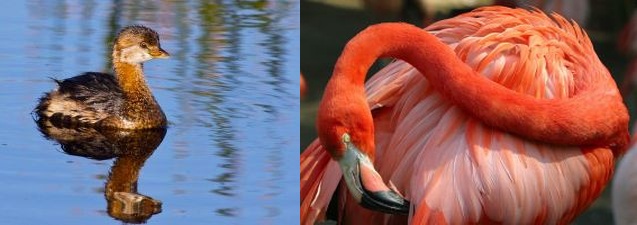
4 January 2013:
If you were looking for the flamingo’s closest living relative it’s unlikely that you’d ever pick a grebe, but it’s true.
As DNA testing became perfected in the late 20th century, scientists naturally turned their attention to birds. What does bird DNA show about their relationships? The studies told us more than we bargained for.
Pictured above are a pied-billed grebe (Podilymbus podiceps) and an American flamingo (Phoenicopterus ruber). Based on DNA research (van Tuinen, et al, 2001) the families of grebes (Podicipediformes) and flamingoes (Phoenicopteriformes) are each other’s closest living relatives. Studies indicate they have a common ancient ancestor which is now extinct.
This finding was only the tip of the iceberg. In many cases DNA testing confirmed previous taxa but in some cases unrelated birds were shown to be related, previously related birds were pulled asunder, taxonomic order had to be revised and scientific names were changed.
This makes for an ever-changing array of new field guides with new names and new orders. The black-bellied whistling duck is now the first bird on the ABA Checklist. Years ago the common loon came first.
I love all this new information but renaming the warblers was more than I could bear. I wish they had tossed out the name Setophaga and called them Dendroica.
(Inspiration for this Tenth Page is from page 70-73 of Ornithology by Frank B. Gill. Pied-billed grebe photo by Chuck Tague. Flamingo photo by Aaron Logan on Wikimedia Commons)
What determines the (sequential) order of the birds in the ABA checklist? I thought it was “least evolved” to “most evolved”, whatever that means. Maybe that was just my preferred field guide’s order at the time (old Golden guide, really liked it).
Having learned the order years ago by virtue of paging through my field guide all the time while birding, one of the hardest parts of doing my Lawrence County reports for PA Birds was putting the narrative in the latest taxonomic order, as requested by the style guide. The latest order never felt right to me, and I had lists and papers all over to help me get it right, and it often took a couple revisions. It was kind of comical…
The ABA Checklist of North American Birds follows the American Ornithological Union’s check-list of names. The AOU Check-list is in taxonomic order which means it “roughly reflects the evolutionary relationships among the taxa” (per Wikipedia). So, at this point DNA testing has convinced ornithologists that the black-bellied whistling ducks evolved first and loons evolved later. And yes, every time they figure out new relationships, the birds are tossed in the air again.
Here is the latest (I think it’s the latest) AOU Check-list Supplement describing why they’ve made the changes: http://www.aou.org/auk/content/129/3/0573-0588.pdf
What made the Black-Bellied Whistling Duck the first bird on the ABA list? I’m not sure I understand what moves bird positions on the list. Thanks.